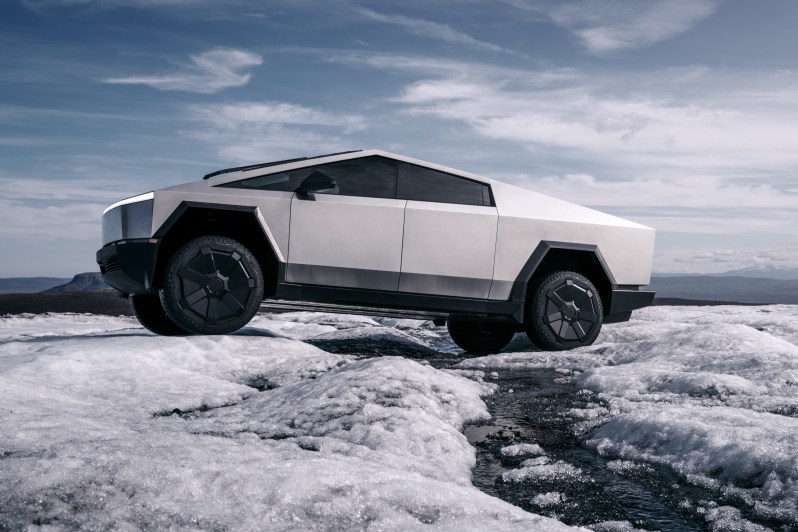
For an automaker, every car plays a crucial role in a lineup. Every car, no matter how small or how affordable, has a spot in a lineup. However, some vehicles are more important than others when it comes to the roles they play in a brand’s lineup. The best cars that define a brand are those that embody everything an automaker stands for.
It can be an interesting feature that’s being passed on to newer models or a car’s mindset that has set the precedent for the rest of the lineup. These 10 cars all play or played a critical role in defining automakers and that set the bar for modern vehicles.

1964 Porsche 911
Few other cars — dare we even say no other modern car — share as much lineage with its original model as the Porsche 911. Originally introduced for the 1964 model year, the rear-engine, flat-six sports car sported a uniquely bulbous design. With the engine hanging off the back and a short wheelbase, the original 911 was a tricky sports car to master, requiring a vigilant driver to pilot.
While today’s Porsche 911 is bigger, easier to drive, and much more capable, it still shares a lot of the same engineering elements and design cues as the original. The 911 remains the brand’s halo car and one of the few options in the lineup that won’t fully succumb to the pressure of modern trends. We couldn’t picture Porsche without the 911.

2003 Jeep Wrangler Rubicon
Dig deep into the Jeep Wrangler’s history, and your research will take you back to the ‘40s when Willys-Overland put a bid on a U.S. military contract with an SUV that eventually became the MB. While everyone knows about the Willys MB, we think the vehicle that really defines Jeep as a brand that puts off-roading first for consumers is the 2003 Jeep Wrangler Rubicon.
Part of the TJ generation of the Wrangler that was introduced in 1997, Jeep came out with the first Rubicon variant of the SUV in 2003. Featuring locking front and rear differentials, large 31-inch all-terrain tires, disc brakes on all four corners, and a lift straight from the factory, it was the most capable Jeep consumers could buy. It was also the first vehicle to wear the Rubicon name, which came from California’s legendary Rubicon Trail. If it weren’t for the Rubicon, we probably wouldn’t have had trail-rated Jeeps and affordable SUVs from the American brand that put off-roading first.

2020 Kia Telluride
Kia’s been making massive strides to being more than just a value brand. For the majority of the automaker’s vehicles, consumers will have to say something about the car’s affordable price tag when explaining why they went with a Kia. Even the incredible Stinger GT has the same issue. But there’s one vehicle in Kia’s lineup where you don’t have to do this, and that’s the Telluride.
All-new for the 2020 model year, the Telluride raises Kia to new heights. Yes, it’s still a great value option, but the value aspect of the midsize SUV plays second fiddle to its rugged yet high-end design, gorgeous interior, and comfortable ride. The Telluride is one of the few SUVs that looks great at a country club and in an urban area. This is the first Kia to prove that the South Korean brand can stick with the big boys based solely on its merit. It’s also a great preview of the direction the brand is taking.

2020 Chevrolet Corvette
Since the Chevrolet Corvette’s introduction in 1953, America’s sports car has followed a simple recipe: Engine at the front and seating for up to two. While things for the Corvette changed over time, the 2020 model year introduced dramatic alterations.
The Corvette has always been a heavyweight in the segment, punching far above its weight class when it comes to performance and value. The transformation to a mid-engine design changes the game for the Corvette forever. We’re eager to see what Chevy has in store for the historic nameplate and expect a proper supercar killer. For everything that it is, the new Corvette reveals just how far Chevy can go with a sports car.

1960 Toyota Land Cruiser FJ40
The 1960 FJ40 Toyota Land Cruiser isn’t the first Land Cruiser ever made. That honor goes to the 20-Series of Land Cruisers from 1958. The Land Cruiser made the list because it immediately became a hit in the United States. From 1961 to 1965, the Land Cruiser was the best-selling Toyota in the U.S. Fast forward to today, and the Land Cruiser is still on sale, looking out of place in a lineup that also includes the Prius and GR Supra. Without the legendary off-roader, Toyota wouldn’t be here, and one of the most capable and reliable SUVs ever made wouldn’t be around. Jeep isn’t the only automaker that makes off-roading-oriented SUVs, and the Land Cruiser proved that.

2005 Mercedes-Benz G55 AMG
Like a few other SUVs on this list, the Mercedes-Benz G-Class has a rich history. Available since the late ‘70s as both a simple off-roader for the masses and as part of a lineup specifically built with the military in mind. Both lines of the G-Class shared a few elements, including a heavy-duty all-wheel-drive system, a narrow stance, and a boxy design. From rally cars and popemobile to police
The G-Class really hit its stride as being a defining vehicle for Mercedes in 2005, when in-house tuning company AMG nestled a supercharged 5.4-liter V8 making 469 horsepower and 516 pound-feet of torque into the engine bay. That figure is still downright absurd today, but, more importantly, for our purposes, it led the way for Mercedes to dig into offering luxurious, incredibly competent, and powerful SUVs. Few off-roaders are this capable and luxurious.

Tesla Cybertruck
Say what you want about Tesla or its outspoken CEO, Elon Musk, but the startup that essentially manifested itself out of thin air has gone to turn the automotive industry on its head. Beating giants like Ford and General Motors to introduce high-tech, useable electric vehicles that consumers actually want to buy. Tesla always seems like it’s one step ahead of the rest. Hands down, Tesla is the most popular electric brand in the world and it has the sales to prove it.
While Ford is busy slapping the Mustang name onto its first real attempt at an electric vehicle, Tesla’s toying with everyone with the Cybertruck. It may as well have been styled by NASA because the futuristic truck looks like it doesn’t belong in this world. While Tesla’s still ironing out the Cybertruck’s official specs, we’re expecting the pickup to be able to tow up to 14,000 pounds and have a range of at least 500 miles. There’s no denying that the funky design, armor glass, and zero-to-60 mph time of 2.9 seconds is overkill. But in a world where every other automaker produces boring cars for the boring slog to work for boring people to buy, the Cybertruck is the good type of crazy. It perfectly encompasses everything Tesla is and, hopefully, will continue to be in the future.

1992 Dodge Viper
Compared to other American automakers, Dodge does things a little differently. The majority of Dodge’s current lineup is ancient and geared toward outright power and speed. That wouldn’t be the case if the brand’s original supercar, the Viper, hadn’t come out in 1992.
An enormous 8.0-liter V10 engine with drive going to the rear wheels and a proper six-speed manual transmission meant the Viper performed like a proper sports car in a straight line. Around corners, though, the Viper was a handful. With side-exit exhaust outlets, offset pedals, and an intolerable cabin, the Viper quickly earned a reputation for being a raw, extreme machine. If it weren’t for the Viper, Dodge may not have had the idea to stuff 707-horsepower engines into pedestrian cars like the Charger and Challenger.

2010 Ford F-150 Raptor
For a very long time, full-size pickup trucks were seen as versatile, heavy-duty vehicles that were primarily good at towing heavy cargo. Great on the farm, terrible everywhere else. That all changed when Ford unveiled the Raptor in 2010. While other automakers had made pickup trucks that were capable off-road, none of them had thought about building something that could tackle desert terrain at high speeds. Ford made it possible for owners to live out their Baja dreams with something that could be bought straight from the factory.
Sure, the original Raptor came out for the 2009 model year, but the 2010 model year makes this list because of the newly available 6.2-liter V8 engine. The optional engine was rated at 411 horsepower and was a crucial part of what gave the pickup its unflinching ability to travel over rough terrain at high speeds. The F-150 Raptor’s suspension allowed for 11.2 inches of wheel travel at the front and over 13 inches at the back. Special Fox racing shocks, big tires, underbody protection, and sport seats all helped the Raptor’s case. If it weren’t for the Raptor, other modern off-roading pickup trucks wouldn’t be available today.

1974 Lamborghini Countach LP 400
I have a love-hate relationship with supercars. At times I despise them and everything they stand for. At others, I can’t get enough of them and wish Jeff Bezos would give away some of his wealth so that every one of us could experience one. But that’s not going to happen.
If there’s one supercar that set off the trend for how radical expensive exotics should be, it’s the 1974 Lamborghini Countach LP 400. The Countach is one of the few vehicles in the automaker’s lineage of V12-powered cars. Then there was the design that had so many sharp edges that you could get a paper cut from just looking at it. The tires were massive, the exhaust pipes were big enough to hide softballs, the flared fender flares mimicked ones on Tonka trucks, and the placement of the vents made it look like it was going to take off at any second.
It may be a bold claim to make, but the Countach really set the tone for future supercars. Nothing has made quite an impression on the world as it did all those years ago. Without the Countach, Lamborghini wouldn’t be the crazed lunatic that it is, and other automakers wouldn’t have been pushing so hard to make their own dramatic
What other cars are V-12 powered?
Speaking of V-12 power, let’s talk about other cars like the above 1974 Lamborghini Countach LP 400. V-12 engines are synonymous with power, luxury, and a truly exhilarating driving experience. While these majestic engines might not be as common as their V6 or V8 counterparts, they still grace the roads in some truly awe-inspiring vehicles. Here are some of the V-12-powered
High-performance beasts
- Ferrari 812 Superfast amd GTS
- Ferrari Daytona SP3
- Lamborghini Aventador S and S Roadster
- Lamborghini Revuelto
- Aston Martin DBS Superleggera and DBS Volante
- Aston Martin Vantage
Luxury cruisers
- Rolls-Royce Phantom
- Rolls-Royce Cullinan
- Bentley Flying Spur Speed
- Bentley Continental GT Speed



